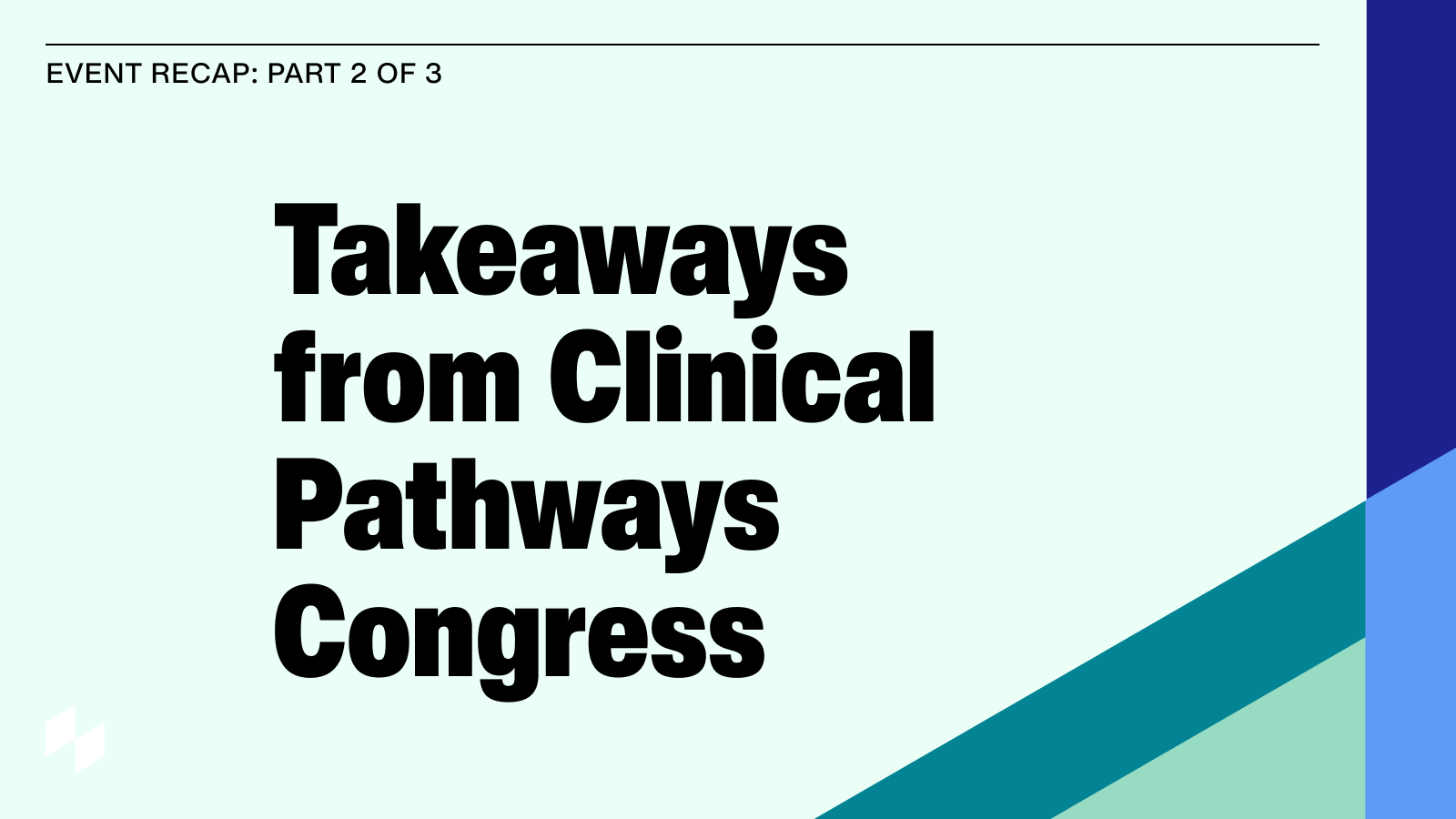With the launch of Medicare's Oncology Care Model (OCM), and commercial insurers' initiation of value-based payment pilots, there has been much discussion around model design, care delivery reform, financial impact (including the cost of transformation), and quality of care. Notably absent from much of this discussion are practical aspects of how practices will do the work. As such, the operational lift for practices has not been given the detailed consideration it deserves as these models have been developed.
Practices face 3 major challenges in today's value-based payment models:
-
Administrative needs, including patient identification and tracking, technical performance and documentation of care plan completion, and quality metric calculation and reporting
-
Identification of old care processes that require transformation, and implementation of new ones
-
Using analytics to measure practice performance on both financial and clinical measures, with the overall goal of improved quality of care at lower cost
Prior to the initiation of the current value-based care pilots, there were essentially no oncology practices succeeding in all 3 areas, and few have yet to address any single challenge efficiently. In order to successfully participate in the variety of payment models available to them, practices must consider whether they will formulate an organic solution or seek external support.
With respect to the administrative challenges, manual processes are a feasible solution, but the additional labor can prove costly and inefficient. Technological solutions, particularly solutions that are integrated into practice management and physician workflow, offer an efficient and comprehensive approach to a daunting task. Given the scale of the OCM, the administrative challenges of this model are an excellent case study of how technology might be applied and would even be necessary.
The Challenge of Value-based Arrangements With Multiple Payers
A majority of practices that are in value-based arrangements, including the OCM, use a fairly sophisticated practice management system and electronic health record (EHR). Even with these tools, the diversity of the patient population creates challenges because practices in these arrangements provide service to many payers. Patients with healthcare coverage through these payers all have different benefit plan designs, and it is common for commercial payer projects to only apply to a subset of all patients (most typically, the fully insured population). Even in the simplest case, Medicare fee-for-service beneficiary eligibility for the OCM features an extensive list of inclusion and exclusion criteria,1 which can be identified by the practice management system but are routinely invisible to the provider at the point of care. Beneficiary eligibility also requires the initiation of therapy with a specific list of both intravenous (IV) and oral agents, with attribution occurring specifically on the date of IV administration or pharmacy dispensing, and then continuing for up to 6 months per episode. Therefore, optimal patient capture would require information exchange between the practice management system and the EHR to verify and document enrollment in a specific value-based program, as well as a mechanism that can track progress through an episode and link the clinical services to billing and collection of applicable management fees. This is certainly achievable through manual processes but clearly lends itself to a technological solution. Flatiron Health offers one such solution to practices utilizing its EHR, OncoEMR.
Flatiron created and applied logic to OncoEMR and practice management data, based on OCM eligibility rules, which helps identify and surface OCM-eligible patients at the practice (Figure 1). These analytics are run on a daily basis in near real-time to track patients who are in an OCM episode or about to enter an episode. In order to identify OCM patients at the point of care, Flatiron built a bridge between its analytics layer and OncoEMR to push the OCM eligibility determinations directly to the patient header in OncoEMR.
The Institute of Medicine (IOM, now called The National Academies of Science, Engineering, and Medicine)'s 13-point care plan2 represents an established and widely accepted standard for documenting communication between oncologists and their patients, as well as among treating physicians to facilitate coordination of care. Despite the consensus that there is value in this document, which ensures the care team and the patient are on the same page, numerous practical issues have hampered implementation. Although most, if not all, elements are routinely documented in the course of care, this is rarely done in an organized fashion in a specific location in the EHR. Oncologists are understandably rarely willing to devote time to such additional documentation, and there is no standard physical format that oncologists can access to share this data with patients and other physicians.
Using a Cross-Collaborative Team
While the OCM has mandated that this care plan be completed for every patient enrolled in the program, it is certainly possible to manually complete all 13 elements. However, given that many of these elements exist in other locations in the EHR, a more elegant and more efficient solution is to electronically pull these data into a single structured document that is fully integrated in the EHR.
Flatiron built a 13-point care plan directly within OncoEMR to the IOM's specifications (Figure 2). Initially, Flatiron's designers and medical oncologists consolidated these 13 points into 9 discrete sections. Then, to avoid duplicating the data, engineers mapped structured data entered in the clinical workflow to the relevant sections of the care plan. When these fields were absent from the structured clinical workflow, such as prognosis and estimated cost, medical oncologists and medical informaticists were brought in to create appropriate data fields within the care plan page. Next, the medical oncology and communications teams crafted patient-facing language, which would surface based on the data fields that were documented. Throughout this cross-functional collaboration, the design and product management teams continued to perform user research and worked to ensure a quick and intuitive user experience.
Finally, for some time, payer contracts have required reporting of quality metrics. As an example, most practices participated in Physician Quality Reporting System; however, the scale of this reporting has been massively expanded—initially by the OCM and subsequently by the Merit-based Incentive Payment System (MIPS), under the Medicare Access and CHIP Reauthorization Act. There are now more measures, reporting is more frequent, and we foresee that patient level detail will ultimately be a requirement. The existing list of required quality metrics reporting may not seem daunting until one begins to understand and execute the precise logic required to identify eligible patients and document physician performance on these measures. While the required processes to report have been precisely defined by the Center for Medicare & Medicaid Innovation (CMMI) as part of the OCM, several of these steps are open to interpretation. In the absence of a consistent process for applying these rules, errors will be inevitable. Since the consequence of "getting it wrong" is either a reduction in savings generated in the OCM or an outright fee schedule penalty under MIPS, there is a strong incentive to "get it right."
The data required to report the quality measures can be in structured fields in the EHR, which makes the ability to automate reporting an obvious advantage. In fact, given the complexity of the processes involved in calculating these measures, the ability to iterate on these measures to guarantee optimal performance makes a technological solution far superior to a manual solution. In addition, the results can be used to populate a dashboard, visible to providers as a process improvement tool.
Automated Quality Measurement
To automate quality measurement, Flatiron's quality team of medical oncologists, quantitative scientists, and data insights engineers first scoped and documented the logic needed to calculate the numerator and denominator of each OCM quality measure from the information available within OncoEMR. These data points were then mapped within OncoEMR. Structured fields were created for data points that did not previously have them. These data elements were then harmonized, normalized, and mapped back to Flatiron's centralized database to create an analytics-ready dataset. With this dataset, Flatiron built logic to calculate the OCM quality measures (Figure 3). Following quality assurance and control, visualization of these quality measurements were built and deployed to OCM practices across 18 states.
Early Results and Lessons from the First 6 Months of the OCM
Flatiron's technological solution has been available to practices using OncoEMR since the start of the OCM (July 2016). With OncoEMR practices comprising nearly 30% of the OCM, initial results of these practices offer interesting insight into implementation and performance. In reviewing the first 6 months (July 1, 2016, to December 31, 2016) of the OCM across 32 practices, we observed 15,705 patients enrolled in the OCM and 5290 care plans completed and distributed to patients. In reviewing financial data for 20 OCM practices during the same time period, we found that these practices received Monthly Enhanced Oncology Services (MEOS) payments averaging a projected $66,673 per medical oncologist per year in the OCM. Based upon these practices' OCM patient volume, only about half of their MEOS revenue potential was realized during this time period.
The results described offer several important lessons. Even with a near comprehensive technological solution for the administrative burden of the OCM, implementation and adoption of new tasks and care processes take time and effort. It involves,
-
Staff training
-
Hiring new staff
-
Modifying physician workflow
These changes cannot be implemented spontaneously. Rather, they would need performance measurements and, where necessary, improvements. Strong executive and physician leadership are vital for the success of all elements of value-based care, but the clear advantages to identifying and co-developing a strategy with a technology partner will make this transition—one for which few practices are currently configured to execute—smoother and much more successful. This will allow practices to focus on the even more challenging elements of care delivery reform. As payers contemplate their goals in value-based care, they must consider the tools available to practices in order to minimize the likelihood that the burdens associated with executing multiple models are so onerous that box-checking gets in the way of real transformation. Patients' lives are at stake.
REFERENCES
1. Oncology Care Model: OCM performance-based payment methodology. Centers for Medicare & Medicaid Innovation website. https://innovation.cms.gov/Files/x/ocm-methodology.pdf. Published June 27, 2016. Accessed February 20, 2017.
2. Institute of Medicine. Committee on Improving the Quality of Cancer Care: Addressing the Challenges of an Aging Population. Delivering high-quality cancer care: charting a new course for a system in crisis. IOM National Academies website. http://nationalacademies.org/hmd/~/media/ Files/Report%20Files/2013/Quality-Cancer-Care/qualitycancercare_rb.pdf. Published September 2013. Accessed February 20, 2017.


